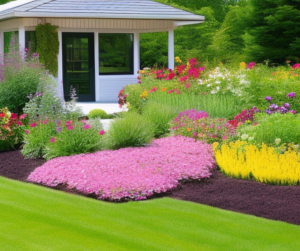Perennial food gardens are a great way to produce fresh, healthy produce for your family all year round without replanting yearly. Not only does this save you time and money, but it also helps reduce waste and improve the environment’s health. Planning and effort allow anyone to create a beautiful and productive perennial food garden.

Here’s everything you need to know to get started:
Choose the Right Location
The first step in creating a perennial food garden is to choose the correct location. The location should be in full sun, with at least six hours of direct sunlight daily. It should also be close to a water source and have well-drained soil. If you don’t have a suitable location in your yard, consider using raised beds or containers.
Plan Your Garden
Once you have chosen the location for your garden, it’s time to plan it out. Start by determining the garden size and the types of plants you want to grow. Some great options for a perennial food garden include fruit trees, berry bushes, and herb plants.
Prepare the Soil
Once you have planned your garden, it’s time to prepare the soil. This involves removing existing plants or grass and adding organic matter, such as compost or aged manure, to the ground to improve fertility. If you’re using raised beds or containers, you’ll need to purchase high-quality soil and fill them with it.
Plant Your Garden
With your soil prepared, it’s time to plant your garden. Start by producing the most significant plants, such as fruit trees and berry bushes. Then, grow the smaller plants around them, such as herbs and vegetables. Be sure to follow the instructions on the plant labels for the best results.
Maintain Your Garden
Once your garden is planted, it’s essential to maintain it properly to ensure that it produces a bountiful harvest. This includes watering regularly, mulching to retain moisture and control weeds, and pruning and training the plants as needed. You’ll also need to fertilize your garden regularly to keep the soil fertile.
Harvest and Enjoy
After a few months, your perennial food garden will produce delicious products for you and your family. Whether you’re harvesting juicy berries, crisp apples, or fragrant herbs, there’s nothing quite like the taste of fresh, home-grown produce.
FAQs
- How long does it take for a perennial food garden to start producing?
It depends on the types of plants you have in your garden, but most perennial food gardens will start producing within a few months of planting. Some fruit trees may take a few years to begin building, while others will start making fruit within a year or two.
- How much maintenance does a perennial food garden require?
A perennial food garden requires regular maintenance, including watering, mulching, pruning, and fertilizing. The upkeep required will depend on the size of your garden and the types of plants you have.
- Can I grow a perennial food garden in a container?
Yes, you can grow a perennial food garden in a container. Just be sure to choose large containers for the plants you want to grow and fill them with high-quality soil.
- What are the benefits of a perennial food garden?
A perennial food garden provides a continuous supply of fresh, healthy produce for your family, and it helps reduce waste and improve the environment’s health.
- How do I choose the right plants for my perennial food garden?
When choosing plants for your perennial food garden, consider your climate, soil type, and the amount of sunlight your garden receives. Some plants are more suitable for specific environments and soil types, so choosing plants that thrive in your area is essential. You can also consider the taste and nutritional value of the product you want to grow and the maintenance required for each type of plant.
- What are the most common pests and diseases that affect perennial food gardens?
Common pests and diseases that affect perennial food gardens include aphids, caterpillars, spider mites, powdery mildew, and fire blight. To prevent these issues, it’s essential to maintain a healthy and balanced garden environment and to inspect your plants for signs of pests or disease regularly. If you notice any problems, it’s best to address them promptly to prevent them from spreading.
- How can I extend the harvest season in my perennial food garden?
To extend the harvest season in your perennial food garden, consider planting a mix of early, mid, and late-season producing plants. You can also use row covers and cold frames to protect your plants and extend the growing season. Another option is to plant various storage crops, such as root vegetables, that can be harvested and stored for later use.
- How can I make the most of the produce from my perennial food garden?
There are many ways to make the most of the products from your perennial food garden. Consider preserving your excess produce by canning, freezing, or drying it. You can also use your fresh produce in various recipes, from salads and smoothies to baked goods and sauces. Don’t forget to share your surplus with friends, family, and your local community.
Conclusion
Creating a perennial food garden is a great way to provide fresh, healthy produce for your family all year round. With some planning and effort, anyone can create a beautiful and productive garden that will provide years of enjoyment and sustenance. So why not start your perennial food garden today and start reaping the benefits of home-grown produce?


